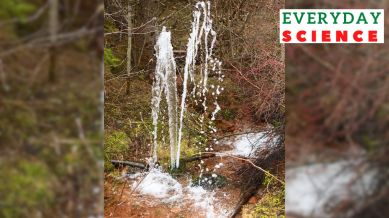Water gushes out from underground in Rajasthan village: What is ‘artesian condition’, responsible for it?
Dr Narayan Das Inakhiya, Senior Hydro-Geologist at the Rajasthan State Ground Water Department, attributed the incident to an “artesian condition”. Here is what to know.

Residents of Taranagar village in Rajasthan’s Jaisalmer district witnessed a unique phenomenon last month when large amounts of water began gushing out from underground on December 27. The water stopped flowing without any external intervention on the night of December 29. Some on social media claimed it was related to the Saraswati river, mentioned in ancient texts like the Rig Veda and believed to have once flowed through the region.
However, scientists have refuted them and pointed to a geological event instead. Here is what to know.
What happened in Jaisalmer?
A farmer in the Mohangarh area of Jaisalmer hired a firm to dig a tube well to tap groundwater. On the morning of December 27, after digging up to 850 feet, water began sprouting from the ground. In about an hour, it began flowing at high pressure, so much so that a truck and a drilling machine also got stuck. The 25 bighas of land nearby came under water as well.
A small amount of non-inflammable gas was released along with the water. A large pit was also created due to the water pressure. Dr Narayan Das Inakhiya, Senior Hydro-Geologist at the Rajasthan State Ground Water Department, attributed the incident in Jaisalmer to an “artesian condition”.
What are artesian conditions?
It has to do with geology. According to the United States Geological Survey’s website, an artesian aquifer refers to water stored under pressure, between layers of sediments and soil below the earth’s surface. It is also described as “confined” water because of hardy materials above and below it.
What differentiates it from water flowing normally through tube wells or wells is that artesian water can sprout from underground on its own, and is also located deeper below the earth’s surface. It is surrounded by poorly permeable rocks that result in high pressure underground. When a rupture (like through drilling) happens, that underground pressure forces water upward and toward land.
The word “artesian” is specifically used when water is “confined under pressure below layers of relatively impermeable rock.” It “comes from the town of Artois in France, the old Roman city of Artesium, where the best known flowing artesian wells were drilled in the Middle Ages,” the website says.
Why was water gushing out in the desert?
Dr Inakhiya explained that in the desert region, water is confined underneath a geological layer of sandstone. As soon as the top layer is punctured, water starts flowing upwards due to heavy pressure. This phenomenon has previously been observed in places such as Mohangarh and Nachana Samiti Panchayat. “But the intensity with which the water was flowing (in Taranagar) has never been seen before,” Dr Inakhiya said.
It has also been spotted in the desert regions of Australia and Africa.
What about the speculation around the Saraswati River being the source of the water?
Experts do not consider this to be linked with the Saraswati River, mentioned in texts such as the Rig Veda. Scientists believe that this water is millions of years old and in no way linked with the river.